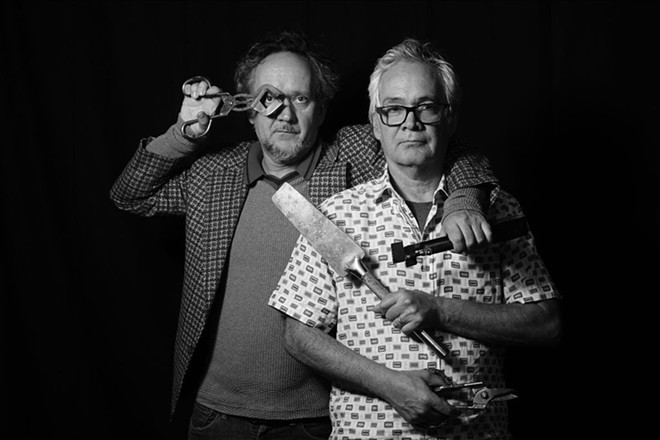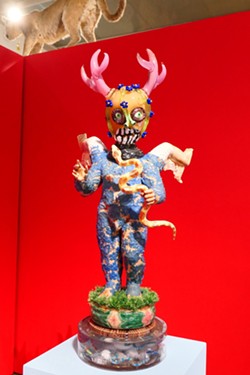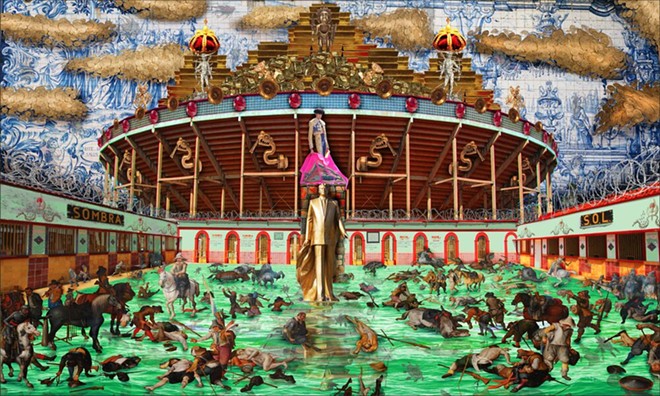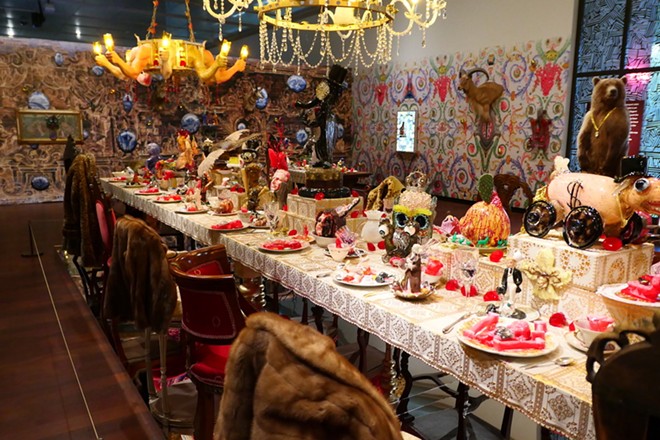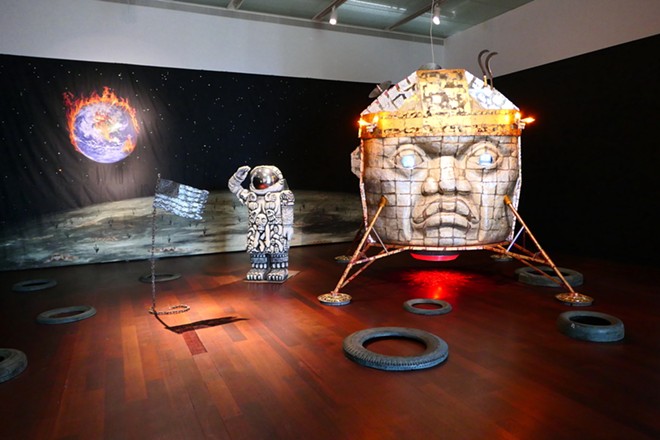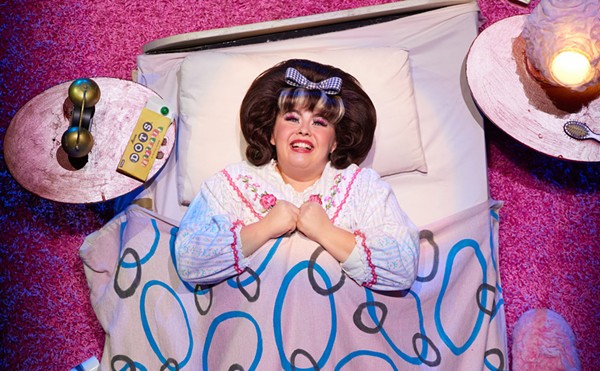Multi-layered, maximalist, dizzying and dazzling, the mixed-media work of brothers Einar and Jamex De La Torre is a chaotic feast for the senses.
Based between San Diego and Baja California, the De La Torre Brothers, as they're simply dubbed, started collaborating in the 1990s and have since developed an expansive aesthetic marked by surreal blown-glass figures, mind-boggling lenticular images and installations resembling fantastical movie sets. Nodding to everything from pre-Columbian deities and Colonialism to horror classics and modern-day monsters, their wide-ranging projects boast narratives as stacked as the objects themselves.
While their mural-like installation Latin Exoskeleton has been dominating the McNay's lobby since last September, the De La Torre Brothers truly arrived in San Antonio with the March 1 opening of "Upward Mobility," an ambitious exhibition divided into four eye-popping chapters. A keystone of the McNay's 70th anniversary programming, "Upward Mobility" represents the artists' largest major museum show in Texas and their first in San Antonio.
Intriguingly, the creative spark for "Upward Mobility" arrived two years ago when McNay Head of Curatorial Affairs René Paul Barilleaux traveled to Riverside, California, to attend the Cheech Marin Center for Chicano Art & Culture's inaugural exhibition — the De La Torre Brothers retrospective "Collidoscope."
"I didn't know the work at all," Barilleaux said. "But when I saw images and video, I was just blown away. So I had to go out there to see for myself. They were there, we met and I almost instantly realized: this is perfect for San Antonio. You could just tell that everybody was happy and they were getting it. Even the kids were into it. And then you have all of the references to Mexican history, Mexican culture and pop culture ... the playfulness of the work, the satire and the informality. ... There's a touring version of the Cheech show that traveled to Corpus Christi and El Paso, but we couldn't make that work. So we reached out to them and said, 'Let's make our own show that's specific to the McNay.'"
Thanks to the easy flow from one over-the-top room to the next, "Upward Mobility" indeed feels tailor-made for the McNay. But as we learned during a walkthrough with Einar De La Torre, the exhibition also includes some remarkable pieces and arrangements created specifically for the occasion. And local culture aficionados will undoubtedly delight in the fact that the entire show is dedicated to Tomás Ybarra-Frausto — the Chicano scholar behind rasquachismo, an underdog sensibility that informs the work of many San Antonio artists.
'Outside of the fishbowl'
Born in 1960s-era Guadalajara, the De La Torre Brothers moved with their mother to Dana Point, California in 1972.
"Our dad is a brilliant architect, but he was also an alcoholic that could get mean," De La Torre recounted. "Finally, my mom had enough and grabbed five out of the six kids and moved to Southern California. So we went from an all-boys Catholic school to a surfing town with [girls in] miniskirts and hot pants. [The] culture shock was beyond imaginable. It was pretty wonderful. In weird ways [those] references still come out in our work. Because of those juxtapositions, we learned that you can be the insider-outsider. And that status puts you in a kind of interesting [place] outside of the fishbowl."
Those deep-rooted juxtapositions come across vividly in what's arguably the De La Torre Brothers' earliest signature: quirky blown-glass characters that celebrate hybridization.
A Lorax-inspired figure wrapped in vines, a luchador navigating the depths of Hell and other mutant-like creatures welcome McNay visitors into "Dark Nature," the exhibition's first thematic chapter.
"[Throughout] this front room, we're talking about dark or strange nature, our relationship to nature and our need to control it," De La Torre said. "But it's not going so well — global warming shows us that we can't control it."
Gesturing to a humanoid figure constructed from glass cactus pads, De La Torre continued, "We wanted to make a nopalero here as [a way to ask], 'What do you get when you breed all of the different people?' You get diversity. You get strength. That's kind of our position."
Dominating the red-walled anteroom, the 2021 opus Vodyanoy exemplifies the artists' mastery of lenticular printing — a medium they fell in love with after happening upon a vintage Disney poster. A novelty associated with 3D advertisements that appear to change or move based on the viewer's perspective, lenticular prints can pack a multitude of layers into one conglomerate image that gets printed on the back side of a finely sliced prism-like lens. Inspired by the Slavic myth of the water spirit Vodyanoy, the piece conjures a historical acid trip that transports a handsome toreador, a dancing frog-man and battling cavalry to La Plaza de Toros Monumental in Tijuana.
"The reason that we love this stuff is that you can have so much information," said De La Torre, who clocks countless hours assembling densely layered Photoshop files for the lenticular prints. "The very same lens is making your eyes focus in front of the substrate and behind it for depth. The other effect that happens isn't just a stereovision of your eyes converging. It's the fact that as you move you see other things appear — and that makes it look like there's more space. But it's just fake — it's totally analog once we get down to it."
Eat the rich
"This is a project we started in Europe ... and it just kept growing," De La Torre explained as we entered "The Mansion." Easily the most jaw-dropping chapter of "Upward Mobility," the Baroque-inspired room is covered in elaborate wallpaper and anchored by a long wooden table evoking a dinner party that took an apocalyptic — even cannibalistic — turn. Glasses of wine are in mid-spill, fur coats are draped over chairs and dishes are filled with blood, eyeballs, tchotchkes and kewpie dolls. Visually thrilling yet undeniably macabre, the entire scene makes one wonder what the hell happened — and why everyone disappeared.
"This is a feast of conspicuous consumption," De La Torre explained. "We're repulsed by it but we're also wishing they invited us."
After pointing out tabletop characters such as Capitalist Pig and Stinking Rich Fly, De La Torre explained that this iteration of the project — titled Le Point de Bascule (The Tipping Point) — is their largest to date.
"The scale of this we've never touched. The biggest table we've done was maybe 10 or 12 feet. This one is about 26 feet. ... When the McNay said they wanted to put it up on a platform, we thought, 'Let's add mirrors so you can see the underbelly.' [There are also] money bags in the chandeliers [above the table]. And we have never made chandeliers before. We thought, if Chihuly can do it, [we can do it]."
The construction of the table — mirrors and all — was handled in-house.
"Our preparatory team had an incredibly fun time working on this exhibition," McNay Curator of Exhibitions Lauren Thompson said. "They had the opportunity to help the brothers fabricate the table and work on the elaborate underside that you see in the mirror."
Outside of their own glass and mixed-media interventions on the doomed dinner party, the De La Torre Brothers scoured local antique stores and thrift shops, borrowed a veritable zoo of taxidermy from a local collector and even shopped for period furniture in the McNay's collection.
"[Some of the furniture] was part of Marion McNay's house," Barilleaux explained. "We've pulled things out that don't get seen."
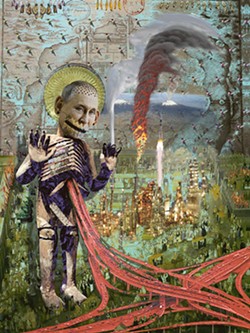
Godzilla vs. Putin
Small but mighty, the third section of "Upward Mobility" evidences the brothers' overlapping interests in politics and horror. Aptly titled "Monster Movie," the dimly lit room is bookended by large lenticular prints that pit two powerful shapeshifters against one another. While the Aztec mother goddess Coatlicue morphs into the Godzilla-inspired Coatzilla, her mortal opponent Mictlantecuhtli — the Aztec god of death — morphs into Vladimir Putin.
"So, these are movie posters," De La Torre said of the prints. "She's grumpy at humanity because we're not taking care of nature — so she's tearing it all up. ... And he's coming at her shooting. ... He's creating more highways with his tribes. He wants the industrial revolution to continue and to make more gasoline and internal combustion engines because it's all about petroleum for him."
Projected on the floor between the two monstrous lenticular prints is an oddly hypnotic video of a particularly busy roundabout along Paseo de la Reforma in Mexico City. Driven home by the scale of the traffic below and the cinematic destruction on either side, the simple act of stepping across the projection — which is amusingly bordered with rug-like fringe — deftly places the unwitting museum-goer in the role of a stomping monster.
"All these rooms have one thing in common — losing control of nature," De La Torre said. "Here we are stomping on Mexico City — and we are the monsters. If he wins, global warming will continue. And if she wins, she'll get rid of all of humanity because we've been terrible."
Lunar anthropology
A De La Torre Brothers "wow" moment since its 2002 debut, the room-sized installation "Colonial Atmosphere" makes for the dramatic finale of "Upward Mobility." In keeping with the duo's interest in hybrid forms, the piece re-envisions an enormous replica of an Olmec head as a lunar lander alongside a pre-Columbian astronaut with painterly nopales and mountains of nachos in the horizon.
"This is the third Coatlicue we have in the show," De La Torre said. "In this case we morphed her with Neil Armstrong in all her glory. ... The idea is that, here we are colonizing the moon — with cactus and chips. ... We came to the States in '72, right when the Apollo 13 series was still landing on the moon. As kids, it affected the hell out of us. This [piece] is a little bit about Rapture theology, which is a very American thing. The idea that you actually get corporally extracted from your home and taken to heaven — and all the unbelievers stay in Hell and have some sort of apocalyptic demise? Well, here we are — burning.
Latinx perspective
Fittingly, "Upward Mobility" has overlapped with the arrival of the McNay's first ever Curator of Latinx Art, Mia Lopez, who helped Barilleaux and Thompson organize the exhibition. Since her arrival last October, Lopez has been combing the McNay's collection and gathering themes for future exhibitions and programs. Following our walkthrough, we asked Lopez if she thought museum founder Marion Koogler McNay might have collected any differently if the term Latinx had existed during her lifetime (1883-1950).
"Something that I think is so interesting about language — and particularly as it pertains to identity politics — is that sometimes something exists but we don't necessarily know that it exists until we name it," Lopez replied. "At the time she was living and collecting in San Antonio, she was surrounded by people that we would now call Latinx. In the work that I'm doing, [I don't want] to project that label backwards. I want to be careful to identify people in terms they wanted to use. But I still think it's really interesting and so important for people to know that the first work that she acquired was Diego Rivera's 1927 portrait of Delfina Flores that is an icon of our collection. And when I think about that as the starting point, it's a reflection of the hybridity of San Antonio."
De La Torre Brothers: 'Upward Mobility,' $10-$20, 10 a.m.-6 p.m. Wednesday, 10 a.m.-9 p.m. Thursday, 10 a.m.-6 p.m. Friday, 10 a.m.-5 p.m. Saturday, noon-5 p.m. Sunday through Sept. 15, McNay Art Museum, 6000 N. New Braunfels Ave., (210) 824-5368, mcnayart.org.
Subscribe to SA Current newsletters.
Follow us: Apple News | Google News | NewsBreak | Reddit | Instagram | Facebook | Twitter| Or sign up for our RSS Feed

